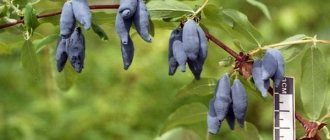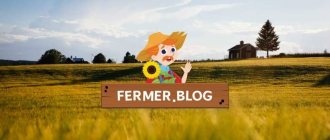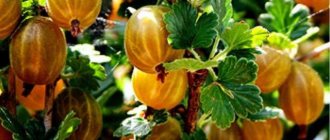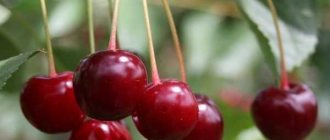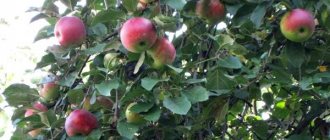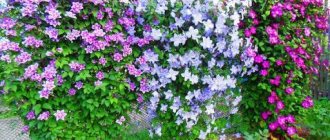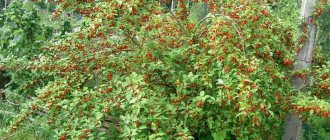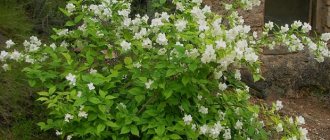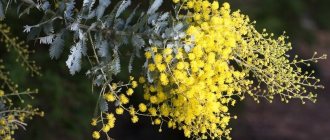Botanical description
The bush is low-growing, spreading, with a rounded crown. The height of the bush reaches 1 m. The shoots are thin and curved. The leaves are dark green in color, they are medium in size, lanceolate. The flowers are large, white-yellow in color. The variety is early ripening.
Description of fruits:
- size - 2–3 cm;
- weight - 0.8–2.5 g;
- shape - elongated-flat;
- color - blue-violet with a whitish coating;
- taste - dessert, sweet and sour;
- Tasting score: 4.7 out of 5.
Diseases and pests
Long-fruited has increased resistance to diseases and pests. But with improper care, diseases may include:
- ramulariasis;
- cercospora;
- tubercularosis;
- powdery mildew;
- leaf mottling;
- mosaic-rezuha.
Video: honeysuckle diseases
To prevent the occurrence and treatment of diseases, spraying with insecticides is carried out - Bordeaux mixture, copper oxychloride, Cuprazone, Fundazol.
Common pests:
The drugs Confidor, Actellik, and Rogor are used for control. Among the traditional methods, spraying with garlic-ash solution, tobacco infusion, and kerosene is effective.
Long-fruited honeysuckle is a tasty and aromatic berry that even a novice summer resident can grow. Resistance to negative environmental factors, as well as the excellent taste of the fruits, have ensured its popularity among gardeners.
Characteristic
Edible long-fruited honeysuckle has its own varietal characteristics, which are listed below.
We recommend reading about honeysuckle variety Delicates.
Frost resistance and drought resistance
The culture has high frost resistance, even in harsh Siberian conditions. Able to withstand frosts down to –7°C during the flowering period. The critical temperature is –45°C. The plant tolerates drought moderately. To get a good harvest, watering is necessary on hot summer days.
Fruiting, productivity
Long-fruited begins to bear fruit at the end of May. The yield is 2.5–3 kg per bush under optimal growing conditions and compliance with the rules of agricultural technology. With normal care, honeysuckle produces no more than 2 kg per bush.
Advantages and disadvantages
- The main advantages of the variety:
- early ripeness;
- high yield;
- large fruit;
- winter hardiness;
- resistance to diseases and pests;
- taste qualities of berries.
- The disadvantages include:
- predisposition to shedding of berries;
- self-sterility;
- low preservation of fruits.
Early and sweet honeysuckle – Long-fruited variety
There are a lot of good honeysuckles. But varieties that have a complex of advantages are especially valued, such as Long-fruited honeysuckle of the Ural selection. It will delight you with early, large and incredibly tasty berries and provide a decent harvest, which is enough to eat fresh and make jam. The plant is unpretentious, and if you rarely appear at the dacha, this is just what you need.
Pollinators
To obtain a good harvest, Longfruit must interact with other species. Otherwise, productivity indicators will be minimal.
The best pollinators of the variety:
- Moraine;
- Chelyabinsk.
Good pollinators:
- Zest;
- Sineglazka;
- Blueberry;
- Enchantress.
Which varieties of honeysuckle need to be planted together for pollination?
Fruiting of the crop begins in the second year after planting. For convenience, experienced gardeners recommend studying the table of honeysuckle pollinators. It will help you understand which varieties are compatible with each other best:
| Shrub name | Suitable pollinator varieties |
| Antoshka | Michurinskoe miracle, Blue dessert |
| Blue spindle | Bluebird, Bakchar giant |
| Gourmand | Nizhny Novgorod early, Start |
| Three friends | Blue dessert, Antoshka |
| Chosen One | Morena, Amphora |
| Tomsk | Sorceress, Blue Spindle |
| Cinderella | Nymph, Blue Bird |
| Princess | Young lady, Blue dessert |
| Michurinsky miracle | Peter the Great, Diana |
How to choose the right pollinator
Before purchasing seedlings, study the characteristics of each variety. The young plant should have high yields, bloom at the same time as other shrubs, and comply with the climatic conditions of the growing region. Descriptions and technical characteristics of varieties are presented on the website of the State Register of the Russian Federation.
Rules of care
Crop care includes a number of standard procedures: watering, fertilizing, loosening the soil, pruning. In early spring and summer, shallow loosening of the soil is carried out to facilitate access of water and air to the roots of the bush.
Honeysuckle is a moisture-loving variety that requires regular watering, but does not like stagnant moisture.
Complex mineral fertilizers are used as fertilizing in spring. In the summer season, if necessary, watering is carried out with a mixture of manure and water 1:4. At the beginning of autumn, fertilize with ash or double superphosphate.
In the first years of life, it is recommended to do sanitary pruning, removing dried and broken shoots. At the 5-6th year of life, the plants undergo rejuvenating pruning and the formation of the plant crown every autumn.
Important! It is strictly forbidden to trim the tops of shoots
—
this can harm the plant and reduce its growth.
Planting and caring for long-fruited honeysuckle
As for agricultural technology, this is one of those varieties that require minimal care. The main period of work occurs in spring - early summer; the rest of the time the bush reminds little of itself. But Long-fruited honeysuckle also has several secrets, knowing which you will always have a harvest.
- When choosing seedlings, give preference to plants grown from cuttings. They have a powerful root system and a low and branched above-ground part. Such a seedling will quickly grow and produce its first harvest in 2–3 years.
- You need to plant the bushes in a sunny place. In this case, the berries will be larger and sweeter, and the harvest will be more abundant.
- The plant will not be damaged by a little wind protection, especially from the north and northeast sides.
- For better pollination, it is advisable to place all varieties of honeysuckle in one area (rows, clumps), but ensure that the feeding area of each specimen is at least 2 m².
- The crop likes soils that are loose and moisture-absorbing, but does not tolerate flooding with groundwater. In the latter case, drainage must be provided.
- Long-fruited honeysuckle prefers organic fertilizers. At least a bucket of humus (compost) should be placed in the hole when planting. It is recommended to sprinkle fruit-bearing bushes with organic matter once every two years, before winter or early spring. In autumn, phosphorus-potassium fertilizers are applied.
- The berries will be larger and juicier if the honeysuckle is watered regularly.
- The shrub loves mulching - in summer mulch prevents the soil from drying out, in winter it protects the roots from freezing.
- In the spring, it is recommended to clean honeysuckle from damaged branches and, if necessary, thin out. The bushes should be well ventilated and receive enough light, then they will bear fruit better.
- To protect the harvest of early berries from birds, the bushes can be covered with a light net.
Honeysuckle is one of those crops that rarely disappoints. Unpretentious and hardy, it will grow in one place for 25–30 years, never ceasing to delight with the first summer berries.
A berry that came to the yard
One of the most important conditions for abundant fruiting of berry crops is the cultivation of zoned varieties adapted to local climatic conditions. Honeysuckle is a guest in the Urals. The natural habitat of the bush is Siberia and the Far East. But thanks to Chelyabinsk breeders, the crop was adapted to such an extent that in terms of yield and quality of fruits it will give a head start to many Siberian, Kamchatka, and Primorye varieties.
Origin and description of the variety
In the Urals, Long-fruited honeysuckle was one of the first to be zoned. We got it from crossing the sweet-fruited Kamchatka form with Altai pollinators. The sample was submitted for state variety testing in 1989, and 5 years later it was included in the State Register.
Read also: Eggshells as medicine
According to the originator - the South Ural Research Institute of Horticulture and Potato Growing - the plant is a medium-sized, widely spreading bush with a mass of thin, slightly curved shoots with purple bark. The leaves are opposite, with a small soft leaf blade, dark green.
The shrub blooms in the first ten days of May, and the berries ripen in about 30–35 days. As the name of the variety suggests, the fruits are elongated in shape, slightly flattened on the sides, with a bumpy surface. The average weight of the berries is 1.3–1.5 g; with good care they can be larger – up to 2 g. The length of the fruit is 2.3–2.7 cm.
The skin is thin, rich bright blue with a waxy coating. The pulp of Long-fruited honeysuckle is tender, juicy, has a dessert taste, with a delicate aroma, which in the description of varieties is usually characterized as refreshing. The tasting score varies in the range of 4.8–5 points.
Productivity largely depends on agricultural technology and weather conditions. In the harsh continental climate of the Urals, 1.5–2 kg of berries are harvested from a bush, in the moderately cold and humid northwestern regions – 2.5–3 kg.
According to the taste characteristics, Long-fruited honeysuckle is a sweet variety - the fruits contain up to 9% sugar and less than 3% acids. With enough moisture there is no bitterness at all. But if the shrub is grown without watering, in especially dry years a piquant bitterness may appear.
The bush is self-sterile. In order for the plant to bear fruit, it is necessary to plant at least 1-2 more varieties suitable for pollination. Recommended pollinators from the Ural assortment are Chernichka, Sineglazka, Chelyabinka, Izyuminka. Lebedushka and Morena of the Leningrad selection are also good choices.
Pros and weaknesses
Long-fruited honeysuckle has a whole range of positive characteristics.
- We have already talked about large fruit, productivity, and taste.
- An undoubted advantage is the high winter hardiness of the variety, the ability to withstand return frosts down to -7⁰ C even at the time of flowering.
- The berries ripen after June 10, and in warm early spring conditions - at the end of May.
- The harvest ripens together, rests securely on the branches, and does not collapse under its own weight or gusts of wind.
- An adult bush is compact, low-growing (1–1.3 m), and does not take up much space. Considering that honeysuckle loves big company, this is an undoubted advantage.
- The plant is easily propagated by cuttings.
But the variety also has a weak side. The spreading form leads to lodging of the lower shoots; accordingly, the berries on them become dirty and can be damaged by insects.
Variety zoning
The variety is zoned in the Chelyabinsk region. But, judging by the reviews of gardeners, it is among the top ten for the middle zone, and has proven itself well in the Leningrad region and Moscow region.
Preparing for the winter season
Honeysuckle “Long-fruited” does not require special preparation for winter, except for scheduled autumn work such as: sanitary pruning, fertilizing and mulching. The plant is able to tolerate any, even the most severe frosts without shelter. This applies to both adult bushes and young seedlings.
Honeysuckle “Long-fruited” will be an excellent option if you want to get sweet berries in the first summer days and at the same time decorate your plot with an attractive berry bush.
